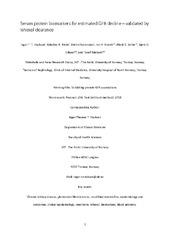| dc.contributor.author | Enoksen, Inger Therese Tønsberg | |
| dc.contributor.author | Rinde, Nikoline Balteskard | |
| dc.contributor.author | Svistounov, Dmitri | |
| dc.contributor.author | Norvik, Jon Viljar Porserud | |
| dc.contributor.author | Solbu, Marit Dahl | |
| dc.contributor.author | Eriksen, Bjørn Odvar | |
| dc.contributor.author | Melsom, Toralf | |
| dc.date.accessioned | 2024-03-25T08:13:58Z | |
| dc.date.available | 2024-03-25T08:13:58Z | |
| dc.date.issued | 2023-08 | |
| dc.description.abstract | Significance Statement - eGFR from creatinine, cystatin C, or both has been primarily used in search of biomarkers for GFR decline. Whether the relationships between biomarkers and eGFR decline are similar to associations with measured GFR (mGFR) decline has not been investigated. This study revealed that some biomarkers showed statistically significant different associations with eGFR decline compared with mGFR decline, particularly for eGFR from cystatin C. The findings indicate that non–GFR-related factors, such as age, sex, and body mass index, influence the relationship between biomarkers and eGFR decline. Therefore, the results of biomarker studies using eGFR, particularly eGFRcys, should be interpreted with caution and perhaps validated with mGFR.<p>
<p>Background - Several serum protein biomarkers have been proposed as risk factors for GFR decline using eGFR from creatinine or cystatin C. We investigated whether eGFR can be used as a surrogate end point for measured GFR (mGFR) when searching for biomarkers associated with GFR decline.<p>
<p>Methods - In the Renal Iohexol Clearance Survey, GFR was measured with plasma iohexol clearance in 1627 individuals without diabetes, kidney, or cardiovascular disease at baseline. After 11 years of follow-up, 1409 participants had one or more follow-up GFR measurements. Using logistic regression and interval-censored Cox regression, we analyzed the association between baseline levels of 12 serum protein biomarkers with the risk of accelerated GFR decline and incident CKD for both mGFR and eGFR.<p>
<p>Results - Several biomarkers exhibited different associations with eGFR decline compared with their association with mGFR decline. More biomarkers showed different associations with eGFRcys decline than with eGFRcre decline. Most of the different associations of eGFR decline versus mGFR decline remained statistically significant after adjustment for age, sex, and body mass index, but several were attenuated and not significant after adjusting for the corresponding baseline mGFR or eGFR.<p>
<p>Conclusions - In studies of some serum protein biomarkers, eGFR decline may not be an appropriate surrogate outcome for mGFR decline. Although the differences from mGFR decline are attenuated by adjustment for confounding factors in most cases, some persist. Therefore, proposed biomarkers from studies using eGFR should preferably be validated with mGFR. | en_US |
| dc.identifier.citation | Enoksen, Rinde, Svistounov, Norvik, Solbu, Eriksen, Melsom. Validation of eGFR for Detecting Associations Between Serum Protein Biomarkers and Subsequent GFR Decline. Journal of the American Society of Nephrology. 2023;34(8):1409-1420 | en_US |
| dc.identifier.cristinID | FRIDAID 2180314 | |
| dc.identifier.doi | 10.1681/ASN.0000000000000147 | |
| dc.identifier.issn | 1046-6673 | |
| dc.identifier.issn | 1533-3450 | |
| dc.identifier.uri | https://hdl.handle.net/10037/33253 | |
| dc.language.iso | eng | en_US |
| dc.publisher | Lippincott, Williams & Wilkins | en_US |
| dc.relation.journal | Journal of the American Society of Nephrology | |
| dc.rights.accessRights | openAccess | en_US |
| dc.rights.holder | Copyright 2023 The Author(s) | en_US |
| dc.title | Validation of eGFR for Detecting Associations Between Serum Protein Biomarkers and Subsequent GFR Decline | en_US |
| dc.type.version | acceptedVersion | en_US |
| dc.type | Journal article | en_US |
| dc.type | Tidsskriftartikkel | en_US |
| dc.type | Peer reviewed | en_US |


 English
English norsk
norsk